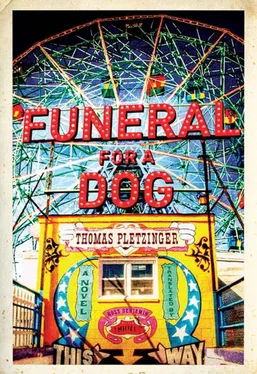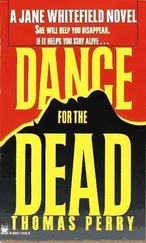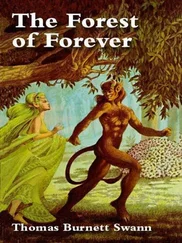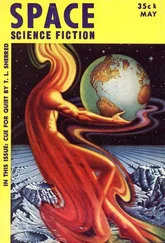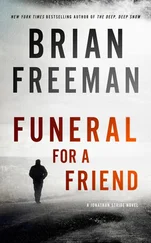M: And how old is the dog?
T: Dog years? Human years?
M: Either way.
T: It must have been at least ten years ago when Felix Blaumeiser, the idiot, brought the dog back from Brazil.
M: May I ask who Felix is?
T: Felix is the reason we’re here, Manteli .
black dogs
Come with me, says Svensson, taking my plastic bag from my hand, it’s my fault. He apologizes stiffly for the chaos, he’d be glad if I stayed the night, we could talk tomorrow in peace (“please forgive the mess”). Then I’ll bring you back to the city in the afternoon, he says, and because I was early this afternoon at the arranged meeting place, because I burst into Svensson’s private life, at this point I answer unemphatically “okay” (otherwise I’d return empty-handed). Svensson’s house is a ruin: three stories of natural stone and wood built at the foot of the cliff, on the side facing the lake green window shutters (closed). The back section of the roof a skeleton, ivy and vine are growing up the walls and into the frame. The flat shed next to the house slants toward the water (it must be a boat shed). Pigeons are fluttering everywhere, their droppings speckle the stone walls. Come with me, Svensson repeats, and I follow him (I’m here to have my questions answered). Lua trudges ahead, coughing, we walk between the sycamore and the garbage heap around the house. A heavy door, then a dark hallway with a terra-cotta floor, pictures all over the walls and framed photographs with black centers (dogs maybe, Lua maybe). We climb a dark staircase, closed doors on the right and left. The dog breathes heavily in the dark, now the smell of smoke is stronger. Svensson opens a door, then a window, and stands in the backlight (Svensson is an opaque man).
crematorium
Over Svensson’s property and over the lake in front of Svensson’s property lies an acrid stench. That’s Claasen, says Svensson, in answer to my question as to whether there isn’t a smell of something burning (state the obvious and casually open the conversation). Clouds of smoke, stretching long and wide, hang over the lake: burning leaves and underbrush, smoldering green wood, burning paper. Svensson is standing with my bag in a room that looks like a study (empty shelves, only a few books). This was my study, he says. Lua flops down on a carpet in a corner of the room. In the other corner lies a mattress with clean sheets. Claasen? I ask, and Svensson nods as if I should be able to understand everything here, as if I had already been here for a long time. Every day at four, says Svensson, Claasen burns another piece of his life. Claasen is his own crematorium.
Can you elaborate on that?
Svensson’s reply: Claasen is his neighbor, a former journalist from Germany, his wife left him, the children are already grown up. Now this pyromaniac in early retirement burns his possessions every day at four, log after log, dry and damp wood, leaves, grass. Svensson opens another window shutter. Furniture, pictures, books. Clothing is the worst. Do you smell that? Melting seventies synthetics: jackets, suits, shirts, dresses. Sometimes Claasen gazes into a book for hours before he throws it into the fire. Depending on the wind direction, a veil of the desire to forget hangs over the shore, when no wind is blowing you sometimes can’t see the other side of the lake (Caravina). Svensson gives me back the bag and turns to the door. Make yourself at home, Mandelkern, get some rest, if you’d like. We’ll call you down for dinner later, and I again say “okay” (you look tired, Mandelkern, Elisabeth would say, lie down).
my assignment, my profession
My assignment: get on the trail of Svensson the man. The true personality of the artist, said Elisabeth after the editorial meeting on Friday, always remains hidden behind success stories (this is what interests Elisabeth). My assignment doesn’t have much to do with my vocation. My profession: I’m an ethnologist, even if my dissertation has been shelved for two years (“Thick Participation and Mediated Identity: A Method in Flux”). It deals with distance and proximity (the ethnological dilemma). Sooner or later, everything I write has to do with me, I think, and of all thoughts it is this one with which Svensson leaves me alone in his room (I find myself in the middle of the group under investigation).
Optolyth
The room has very high ceilings. The shelves on the walls are nearly empty: a little bit of dust on them as if the books were only just removed, a few novels left behind. On the wall hang three large paintings (about 1 x 2 meters), opposite them under the three windows looking out on the lake stands a small, tidy desk, arranged on it along an invisible grid: two small yogurt jars (La Laitière), in the first a yellow pencil, some paper clips, loose change (Swiss francs, dollars, euros, reais ), in the second a few crayons. Then a letter holder (without letters), an inkwell (without ink), in the middle a pair of binoculars (Optolyth). A hotel bill for 84.50 euros (Hotel Stella d’Italia, dated August 4, 2004). On the back of the desk a row of reference books (show me what you read, and I’ll tell you who you are, Elisabeth once said to me, referring to my ethnographies, theoretical writings, lists, and notebooks). Next to the reference books a green plastic picture frame, in it a photo of Svensson and Tuuli. She’s smiling, she looks tired, between them a blond man. Svensson is holding the camera. In the background a chimney, the three faces pale and red-eyed from the flash; the blond man is laughing exuberantly and holding a beer can up to the camera (Pabst Blue Ribbon). And finally, the outlines of a monitor and a keyboard in the dust on the desk. I put my bag on the desk and take out my notebook. It’s now Saturday afternoon, Elisabeth will have gone to the office today despite everything. She’ll drink water and write until her headache is gone. She’ll try to call me at the Hotel Lido Seegarten, she’ll dial my cell phone number. She’ll realize that I’ve run off (I take notes to leave a trail, each word a pebble, each sentence a row of little stones). The smoke hangs low and thick and dense over the water.
Shoot the Freak
The paintings on Svensson’s wall: 1. two old men in front of a wire fence, behind it shiny red lettering (Astroland); 2. a roller coaster and smoke (old dragon). The third and middle painting shows a very thin man in a purple T-shirt at the foot of a green children’s slide. Behind him red tower blocks, snack stands, ocean waves, and hot dogs. The man is in the middle of all this, his eyes are ill at ease, they look straight ahead and seem to threaten the painter. His pants are pulled down and hang around his thin legs, his cock is sticking out from his body (erect, pale). All the paintings in thick oil on canvas, with bottle caps, sand, and beach grass pressed into them. The brushstrokes and colors are reminiscent of the pictures in Svensson’s children’s book. Between a hot dog stand and a lottery stand stretches a series of bright-colored pennants, on each pennant a letter: SHOOT*THE*FREAK. The man resembles Svensson (self-portrait). Svensson is a strange man.
Der Lindenbaum
In my head this image remains: Elisabeth moving into her new office in the spring of 2003. I put two moving boxes down on the carpet, she sits on her desk and watches me. Marry me, she says (the commanding green of her eyes). I laugh, I close the doors to the hallway and the other offices, but then the telephone rings, and Elisabeth says, wait here, Mandelkern, wait for me.
Who exactly is Dirk Svensson?
Sister Carrie by Theodore Dreiser
Onkel Tobi by Hans G. Lenzen
Water Supply Systems for Home Farming by Williams & Steynman The Great Encyclopedia of Dog Breeds
Читать дальше
